Tiger Woods and His “Cocktail” of Drugs: Lucky to Be Alive?

On May 29, 2017, Tiger Woods was found asleep in his car in the middle of a highway in Jupiter, Florida. Police gave him field sobriety tests which he failed. He was also slow and confused as they questioned him and he was taken into custody. While a urine sample went off for toxicology analysis, Woods entered a DUI diversion program as part of a plea agreement to get help for what he described as “an unexpected reaction to prescribed medications.”
The toxicology results revealed a dangerous cocktail of prescription drugs in his system. The list included:

- Hydrocodone, a generic form of Vicodin (opioid painkiller)
- Hydromorphone, also known as Dilaudid (opioid painkiller)
- Alprazolam, also known as Xanax, prescribed for anxiety and panic disorders, a benzodiazepine
- Zolpidem, also known as Ambien, a sedative prescribed for insomnia.
There were also remnants of earlier marijuana use. It’s not known if Tiger had been supplied with medical marijuana.
Was this a particularly dangerous mix of medications? Was Tiger lucky to be intercepted by police before this mix could kill him? For comparison, let’s look at the list of drugs present when actor Heath Ledger died in New York in 2008.
- Oxycodone (opioid painkiller)
- Hydrocodone (opioid painkiller)
- Alprazolam (Xanax)
- Diazepam, also known as Valium, prescribed for anxiety and panic disorders, a benzodiazepine
- Temazepam, also known as Restoril, prescribed for anxiety and sleep problems, a benzodiazepine
- Doxylamine, also known as Unisom, a nonprescription antihistamine that acts as a sleep aid.
Opioids and benzodiazepines taken together can have fatal consequences. In Ledger’s case, it wasn’t any just one of these drugs that killed him, it was the combination.
Why Were They Taking These Drugs?
For the moment, let’s assume that neither person was taking these drugs recreationally. So why would they be taking them?

According to an in-depth profile on Ledger in New York Magazine, Ledger was stressed about his work, his recent separation from his daughter’s mother and being apart from his daughter while filming in London. It’s possible he also had pneumonia from the cold, wet London scenes he had been filming and he was having trouble sleeping. Thus he wound up with this list of medications, perhaps from multiple doctors.
In April 2017, USA Today reported that Woods had recently his fourth surgery on his back since April 2014. He’d also had four surgeries on his left knee. In a statement he released after his arrest, he said "Recently, I had been trying on my own to treat my back pain and a sleep disorder, including insomnia, but I realize now it was a mistake to do this without medical assistance.” It’s possible that Woods had received these drugs after his surgeries but was taking them in dosages or combinations that were not recommended.
Both these men were very likely only taken medications that had been prescribed for them at one time or another—but possibly not with the intention that the whole list would be taken at one time. In Ledger’s case, his dangerous, overmedicated condition was not detected in time to save his life. In Woods’ case, it was. It seems very possible that if Woods’ overmedication was not detected at this time, he could have suffered the same fate as Ledger.
The Lessons to Be Taken
From this loss and near miss, the lessons we can take are that it’s far too easy to get overmedicated to a life-threatening degree and that anytime multiple medications are prescribed, that list needs to be carefully scrutinized by medical staff and family alike. It’s very well-known by both doctors and recreational drug users that combining benzodiazepines and opioids can be a fatal move.
Both those who rely on these drugs medically and those who use them recreationally need support from their families. Both need close monitoring. The patient who has learned to rely on these drugs may need the support of a medical professional to achieve a healthier lifestyle without so many medications. The recreational user also needs professional help to leave the drugs behind and learn how to enjoy life without drugs.
It’s likely that Woods realizes how dangerous his situation was. He’s very fortunate that the Palm Beach County Sheriff's Office found him when they did.


 ®
®